
Air Pollution, Obesity Linked to Significant Liver Fibrosis in Patients With MASH
Key Takeaways
- Obesity and air pollution exposure significantly increase liver fibrosis risk in patients with MASH, particularly in Staten Island and Brooklyn.
- Higher neighborhood income was associated with increased fibrosis odds, diverging from previous research linking poverty to liver disease.
There was no association observed between lower income and increased fibrosis among New York City residents with metabolic dysfunction-associated steatohepatitis (MASH).
Among New York City residents with
Researchers found that residents of Staten Island and Brooklyn had the highest mean liver stiffness scores, while Manhattan residents had the lowest. These findings were based on data from 422 adults and 41 children in the MASLD/MASH Center of Excellence Registry & Biobank. More than half of the cohort lived in Manhattan (51%), followed by the Bronx (19%), Queens (18%), Brooklyn (10%), and Staten Island (2%).
A healthy liver has a kPa reading between 2 and 6, and 38% of patients had significant liver fibrosis with a kPa above 8. While having the lowest proportion of residents in the study, the highest mean scores were measured in Staten Island (15.75 kPa) and Brooklyn (12.6 kPa). Manhattan had the most patients but the lowest mean score with 8.9 kPa. However, liver stiffness was not statistically different between the boroughs.
Does Obesity Exacerbate Air Pollution Effects?
The analysis revealed several environmental and neighborhood-level risk factors, with air pollution standing out.
“Air pollution increases oxidative stress and adipose tissue inflammation and elevates the risk for comorbidities, all of which could negatively influence fibrosis in MASH,” they said. “One extreme example of the impact of air particulate matter on liver steatosis was realized after the WTC [World Trade Center] collapse on where data from our institutional WTC program also found significant dust, PM2.5 released into the air along with chemicals to be associated with toxin-associated liver steatosis (TASH) in first responders who arrived earliest on the scene.”
The study found no consistent association between lower income and fibrosis. In fact, higher neighborhood-level income was associated with greater odds of fibrosis in several subgroups, including adults with diabetes and Hispanic individuals of North or Central American descent. While this finding diverges from prior research linking poverty to liver disease risk, the authors suggest that referral bias and post-COVID lifestyle shifts among higher-income groups may have influenced the results. Other protective or mitigating factors included greater access to educational resources and public parks. In multivariable analyses, high school graduation rates and proximity to green space were tied to lower odds of significant fibrosis in non-Hispanic patients and those with diabetes.
Alcohol consumption, often implicated in liver disease progression, was linked to lower odds of significant fibrosis in this study, but only at low to moderate levels; adults with higher AUDIT-C scores still below hazardous thresholds showed reduced odds of fibrosis (OR, 0.75; 95% CI, 0.61-0.92). The authors cautioned this may reflect reverse causality or self-reporting bias, highlighting the need for more objective alcohol-use data.
They also flagged the limitations of relying on electronic health record–based ethnicity classifications, which may underrepresent genetic diversity. This includes varying single nucleotide polymorphisms among Hispanic populations based on country of origin, as past research demonstrated a higher PNPLA3 polymorphism prevalence among Hispanic individuals from Mexico (33%) than those from the Dominican Republic (16%), emphasizing the importance of subpopulation analysis.2
While causal relationships could not be confirmed due to the cross-sectional design, the study supports growing evidence that chronic exposure to pollutants may worsen metabolic liver disease, particularly in high-risk urban populations.1
“Utilizing these findings to support other studies to target areas where populations are at risk of significant fibrosis, implement screening and diagnostic algorithms, and timely access to novel treatments will be critical,” the authors concluded.
References
- Paredes-Marin A, Napoli J, Sivakumar V, et al. Identifying environmental factors associated with significant fibrosis in metabolic dysfunction-associated steatotic liver disease/steatohepatitis. Dig Dis Sci. Published online June 19, 2025. doi:10.1007/s10620-025-09138-0
- Kallwitz ER, Daviglus ML, Allison MA, et al. Prevalence of suspected nonalcoholic fatty liver disease in Hispanic/Latino individuals differs by heritage. Clin Gastroenterol Hepatol. 2015;13(3):569-576. doi:10.1016/j.cgh.2014.08.037
Newsletter
Stay ahead of policy, cost, and value—subscribe to AJMC for expert insights at the intersection of clinical care and health economics.









































